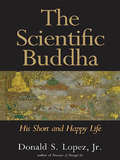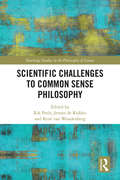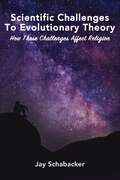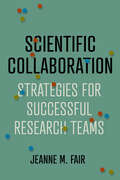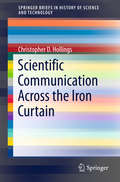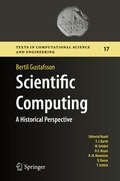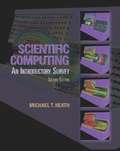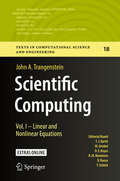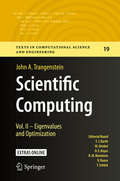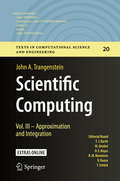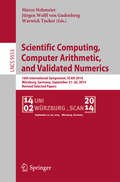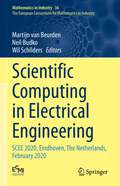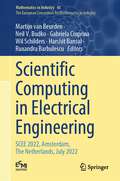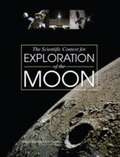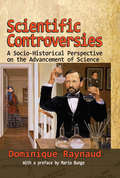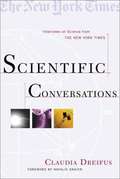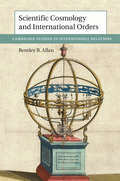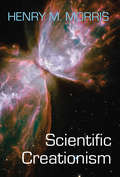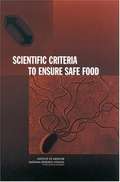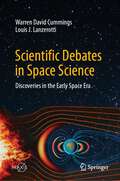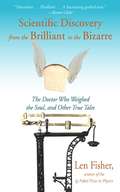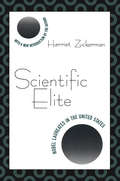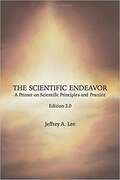- Table View
- List View
The Scientific Buddha: His Short and Happy Life
by Donald S. Lopez Jr.This book tells the story of the Scientific Buddha, "born" in Europe in the 1800s but commonly confused with the Buddha born in India 2,500 years ago. The Scientific Buddha was sent into battle against Christian missionaries, who were proclaiming across Asia that Buddhism was a form of superstition. He proved the missionaries wrong, teaching a dharma that was in harmony with modern science. And his influence continues. Today his teaching of "mindfulness" is heralded as the cure for all manner of maladies, from depression to high blood pressure. In this potent critique, a well-known chronicler of the West's encounter with Buddhism demonstrates how the Scientific Buddha's teachings deviate in crucial ways from those of the far older Buddha of ancient India. Donald Lopez shows that the Western focus on the Scientific Buddha threatens to bleach Buddhism of its vibrancy, complexity, and power, even as the superficial focus on "mindfulness" turns Buddhism into merely the latest self-help movement. The Scientific Buddha has served his purpose, Lopez argues. It is now time for him to pass into nirvana. This is not to say, however, that the teachings of the ancient Buddha must be dismissed as mere cultural artifacts. They continue to present a potent challenge, even to our modern world.
Scientific Challenges to Common Sense Philosophy (Routledge Studies in the Philosophy of Science)
by Rik Peels Jeroen De Ridder René Van WoudenbergCommon sense philosophy holds that widely and deeply held beliefs are justified in the absence of defeaters. While this tradition has always had its philosophical detractors who have defended various forms of skepticism or have sought to develop rival epistemological views, recent advances in several scientific disciplines claim to have debunked the reliability of the faculties that produce our common sense beliefs. At the same time, however, it seems reasonable that we cannot do without common sense beliefs entirely. Arguably, science and the scientific method are built on, and continue to depend on, common sense. This collection of essays debates the tenability of common sense in the face of recent challenges from the empirical sciences. It explores to what extent scientific considerations—rather than philosophical considerations—put pressure on common sense philosophy. The book is structured in a way that promotes dialogue between philosophers and scientists. Noah Lemos, one of the most influential contemporary advocates of the common sense tradition, begins with an overview of the nature and scope of common sense beliefs, and examines philosophical objections to common sense and its relationship to scientific beliefs. Then, the volume features essays by scientists and philosophers of science who discuss various proposed conflicts between commonsensical and scientific beliefs: the reality of space and time, about the nature of human beings, about free will and identity, about rationality, about morality, and about religious belief. Notable philosophers who embrace the common sense tradition respond to these essays to explore the connection between common sense philosophy and contemporary debates in evolutionary biology, neuroscience, physics, and psychology.
Scientific Challenges to Common Sense Philosophy (Routledge Studies in the Philosophy of Science)
by Rik Peels; Jeroen de Ridder; René van WoudenbergCommon sense philosophy holds that widely and deeply held beliefs are justified in the absence of defeaters. While this tradition has always had its philosophical detractors who have defended various forms of skepticism or have sought to develop rival epistemological views, recent advances in several scientific disciplines claim to have debunked the reliability of the faculties that produce our common sense beliefs. At the same time, however, it seems reasonable that we cannot do without common sense beliefs entirely. Arguably, science and the scientific method are built on, and continue to depend on, common sense.This collection of essays debates the tenability of common sense in the face of recent challenges from the empirical sciences. It explores to what extent scientific considerations—rather than philosophical considerations—put pressure on common sense philosophy. The book is structured in a way that promotes dialogue between philosophers and scientists. Noah Lemos, one of the most influential contemporary advocates of the common sense tradition, begins with an overview of the nature and scope of common sense beliefs, and examines philosophical objections to common sense and its relationship to scientific beliefs. Then, the volume features essays by scientists and philosophers of science who discuss various proposed conflicts between commonsensical and scientific beliefs: the reality of space and time, about the nature of human beings, about free will and identity, about rationality, about morality, and about religious belief. Notable philosophers who embrace the common sense tradition respond to these essays to explore the connection between common sense philosophy and contemporary debates in evolutionary biology, neuroscience, physics, and psychology.
Scientific Challenges to Evolutionary Theory: How these Challenges Affect Religion
by Jay SchabackerScientific Challenges to Evolutionary Theory: How These Challenges Affect Religion addresses all aspects of the giant battle between two major belief systems…those that believe in a ‘naturalistic worldview’ and evolution, and those that believe in a miracle-performing God and the Creation of all things.On a trip to Mount St. Helens, some look at the catastrophic eruption of May 18, 1981 as a significant corroboration of the Creation event. Others, deniers of the possibilities of miracles, hold to the view that God’s creation cannot be taken seriously by the scientific community.At the Mount St. Helens book store, I asked about books for sale that gave a Christian view of the catastrophic eruption. The reply was, “I’m sorry, sir, but we only carry books by scientists.”It was time for the author, Jay Schabacker, to do a little scientific sleuthing. Join Jay Schabacker as you learn of the hundreds, even thousands, of Ph.D. scientists who repudiate the theory of evolution, but hold rather to the truth of the theory of Creation.Significant general information, likely new to most readers gives corroborative evidence from many sources, including:• From all over the ancient world, hundreds of accounts of a global flood• Well documented accounts of the Ark of Noah, indeed, located at the top of Mount Ararat• Ancient ‘Near East’ finds, inscribed on rock, told of the actual details covered in the Holy Bible Numerous scientific papers refute the naturalistic dogma forced on us the government, public schools, universities and media. You’ll find arguments that assert:• The earth’s geological features appear to have been fashioned by rapid catastrophic processes that affected the earth on a global scale.• Life on earth was suddenly created, not over billions of years.• The use of radiometric dating method is often grossly in error.• The fossil record shows that all present living kinds of animals and plants have remained fixed since creation.• Mutations and natural selection are insufficient to have brought about any emergence of living kinds from a simple primordial organism.• The universe has “obvious manifestations of an ordered, structural plan and design.” The universe and the solar system were suddenly created. If evolution is wrong why are our children being only taught it in our public schools? Numerous polls favored biology teachers teaching Darwin’s Theory of evolution, but also the scientific evidence against it. The final section of the book gets further into the “Action Plan” where church pastors and members, scientist groups, etc., could make an important difference if:• We all read about the subject and started the conversation;• We gave our views to the school boards and legislators who are the decision makers;• We initiate needed petitions in support needed legislation; and• We urge church pastors to create their own church schools and concerned families to start home schooling for their children.
Scientific Communication Across the Iron Curtain
by Christopher D. HollingsThis monograph provides a concise introduction to the tangled issues of communication between Russian and Western scientists during the Cold War. It details the extent to which mid-twentieth-century researchers and practitioners were able to communicate with their counterparts on the opposite side of the Iron Curtain. Drawing upon evidence from a range of disciplines, a decade-by-decade account is first given of the varying levels of contact that existed via private correspondence and conference attendance. Next, the book examines the exchange of publications and the availability of one side's work in the libraries of the other. It then goes on to compare general language abilities on opposite sides of the Iron Curtain, with comments on efforts in the West to learn Russian and the systematic translation of Russian work. In the end, author Christopher Hollings argues that physical accessibility was generally good in both directions, but that Western scientists were afflicted by greater linguistic difficulties than their Soviet counterparts whose major problems were bureaucratic in nature. This volume will be of interest to historians of Cold War science, particularly those who study communications and language issues. In addition, it will be an ideal starting pointing for anyone looking to know more about this fascinating area.
Scientific Computing: A Historical Perspective (Texts in Computational Science and Engineering #8)
by Bertil GustafssonThis book explores the most significant computational methods and the history of their development. It begins with the earliest mathematical / numerical achievements made by the Babylonians and the Greeks, followed by the period beginning in the 16th century. For several centuries the main scientific challenge concerned the mechanics of planetary dynamics, and the book describes the basic numerical methods of that time. In turn, at the end of the Second World War scientific computing took a giant step forward with the advent of electronic computers, which greatly accelerated the development of numerical methods. As a result, scientific computing became established as a third scientific method in addition to the two traditional branches: theory and experimentation. The book traces numerical methods’ journey back to their origins and to the people who invented them, while also briefly examining the development of electronic computers over the years. Featuring 163 references and more than 100 figures, many of them portraits or photos of key historical figures, the book provides a unique historical perspective on the general field of scientific computing – making it a valuable resource for all students and professionals interested in the history of numerical analysis and computing, and for a broader readership alike.
Scientific Computing: An Introductory Survey
by Michael T. HeathThis book presents a broad overview of numerical methods for solving all the major problems in scientific computing.
Scientific Computing: Eigenvalues And Optimization (Texts In Computational Science And Engineering #19)
by John A. TrangensteinThis is the first of three volumes providing a comprehensive presentation of the fundamentals of scientific computing. This volume discusses basic principles of computation, and fundamental numerical algorithms that will serve as basic tools for the subsequent two volumes. This book and its companions show how to determine the quality of computational results, and how to measure the relative efficiency of competing methods. Readers learn how to determine the maximum attainable accuracy of algorithms, and how to select the best method for computing problems. This book also discusses programming in several languages, including C++, Fortran and MATLAB. There are 80 examples, 324 exercises, 77 algorithms, 35 interactive JavaScript programs, 391 references to software programs and 4 case studies. Topics are introduced with goals, literature references and links to public software. There are descriptions of the current algorithms in LAPACK, GSLIB and MATLAB. This book could be used for an introductory course in numerical methods, for either upper level undergraduates or first year graduate students. Parts of the text could be used for specialized courses, such as principles of computer languages or numerical linear algebra.
Scientific Computing: Eigenvalues And Optimization (Texts In Computational Science And Engineering #19)
by John A. TrangensteinThis is the second of three volumes providing a comprehensive presentation of the fundamentals of scientific computing. This volume discusses more advanced topics than volume one, and is largely not a prerequisite for volume three. This book and its companions show how to determine the quality of computational results, and how to measure the relative efficiency of competing methods. Readers learn how to determine the maximum attainable accuracy of algorithms, and how to select the best method for computing problems. This book also discusses programming in several languages, including C++, Fortran and MATLAB. There are 49 examples, 110 exercises, 66 algorithms, 24 interactive JavaScript programs, 77 references to software programs and 1 case study. Topics are introduced with goals, literature references and links to public software. There are descriptions of the current algorithms in LAPACK, GSLIB and MATLAB. This book could be used for a second course in numerical methods, for either upper level undergraduates or first year graduate students. Parts of the text could be used for specialized courses, such as nonlinear optimization or iterative linear algebra.
Scientific Computing: Eigenvalues And Optimization (Texts In Computational Science And Engineering #19)
by John A. TrangensteinThis is the third of three volumes providing a comprehensive presentation of the fundamentals of scientific computing. This volume discusses topics that depend more on calculus than linear algebra, in order to prepare the reader for solving differential equations. This book and its companions show how to determine the quality of computational results, and how to measure the relative efficiency of competing methods. Readers learn how to determine the maximum attainable accuracy of algorithms, and how to select the best method for computing problems. This book also discusses programming in several languages, including C++, Fortran and MATLAB. There are 90 examples, 200 exercises, 36 algorithms, 40 interactive JavaScript programs, 91 references to software programs and 1 case study.Topics are introduced with goals, literature references and links to public software. There are descriptions of the current algorithms in GSLIB and MATLAB.This book could be used for a second course in numerical methods, for either upper level undergraduates or first year graduate students. Parts of the text could be used for specialized courses, such as nonlinear optimization or iterative linear algebra.
Scientific Computing, Computer Arithmetic, and Validated Numerics
by Marco Nehmeier Jürgen Wolff von Gudenberg Warwick TuckerThis book constitutes the refereed post proceedings of the16th International Symposium, SCAN 2014, held in Würzburg, Germany, in September 2014. The 22 full papers presented were carefullyreviewed and selected from 60 submissions. The main concerns of research addressed by SCAN conferences are validation, verification or reliable assertions of numerical computations. Interval arithmetic and other treatments of uncertainty are developed as appropriate tools.
Scientific Computing in Electrical Engineering: SCEE 2020, Eindhoven, The Netherlands, February 2020 (Mathematics in Industry #36)
by Martijn Van Beurden Neil Budko Wil SchildersThe conference has an interdisciplinary focus and aims to bring together scientists – mathematicians, electrical engineers, computer scientists, and physicists, from universities and industry – to have in-depth discussions of the latest scientific results in Computational Science and Engineering relevant to Electrical Engineering and to stimulate and inspire active participation of young researchers.
Scientific Computing in Electrical Engineering: SCEE 2022, Amsterdam, The Netherlands, July 2022 (Mathematics in Industry #43)
by Martijn Van Beurden Neil V. Budko Gabriela Ciuprina Wil Schilders Harshit Bansal Ruxandra BarbulescuThis volume comprises selected papers presented at the 14th International Conference on Scientific Computing in Electrical Engineering, SCEE 2022, held in Amsterdam, The Netherlands, in July 2022. The aim of the SCEE 2022 conference was to bring together scientists – mathematicians, electrical engineers, computer scientists, and physicists, from universities and industry – to have in-depth discussions of the latest scientific results in Computational Science and Engineering relevant to Electrical Engineering and to stimulate and inspire active participation of young researchers.This extensive reference work is divided into four parts: Part I Circuit Simulation and Design.- Part II Device Simulation.- Part III Computational Electromagnetics.- Part IV Mathematical and Computational Methods. Each part starts with a general introduction, followed by the respective contributions. The book will appeal to mathematicians and electricalengineers. Further, it introduces algorithm and program developers to recent advances in the other fields, while industry experts will be introduced to new programming tools and mathematical methods.
The Scientific Context for EXPLORATION of the MOON
by National Research Council of the National AcademiesBecause of the Moon’s unique place in the evolution of rocky worlds, it is a prime focus of NASA’s space exploration vision. Currently NASA is defining and implementing a series of robotic orbital and landed missions to the Moon as the initial phase of this vision. To realize the benefits of this activity, NASA needs a comprehensive, well-validated, and prioritized set of scientific research objectives. To help establish those objectives, NASA asked the NRC to provide guidance on the scientific challenges and opportunities enabled by sustained robotic and human exploration of the Moon during the period 2008-2023 and beyond. This final report presents a review of the current understanding of the early earth and moon; the identification of key science concepts and goals for moon exploration; an assessment of implementation options; and a set of prioritized lunar science concepts, goals, and recommendations. An interim report was released in September 2006.
The Scientific Context for Exploration of the Moon--Interim Report
by National Research Council of the National AcademiesBecause of the Moon's unique place in the evolution of rocky worlds, it is a prime focus of NASA's space exploration vision. Currently NASA is defining and implementing a series of robotic orbital and landed missions to the Moon as the initial phase of this vision. To realize the benefits of this activity, NASA needs a comprehensive, well-validated, and prioritized set of scientific research objectives. To help establish those objective, NASA asked the NRC to provide guidance on the scientific challenges and opportunities enabled by sustained robotic and human exploration of the Moon during the period 2008-2013+. This interim report, which focuses on science of the Moon, presents a number of scientific themes describing broad scientific goals important for lunar research, discussions of how best to reach these goals, a set of three priority areas that follow from the themes, and recommendations for these priorities and related areas. A final report will follow in the summer of 2007.
Scientific Controversies: A Socio-Historical Perspective on the Advancement of Science
by Dominique Raynaud Mario BungeIn Scientific Controversies, Dominque Raynaud shows how organized debates in the sciences help us establish or verify our knowledge of the world. If debates focus on form, scientific controversies are akin to public debates that can be understood within the framework of theories of conflict. If they focus on content, then such controversies have to do with a specific activity and address the nature of science itself. Understanding the major focus of a scientific controversy is a first step toward understanding these debates and assessing their merits.Controversies of unique socio-historic context, disciplines, and characteristics are examined: Pasteur's germ theory and Pouchet's theory of spontaneous generation; vitalism advocated at Montpellier versus experimental medicine in Paris; the science of optics about the propagation of visual rays; the origins of relativism (the Duhem-Quine problem). Touching on the work of Boudon, Popper, and others, Raynaud puts forward an incrementalist theory about the advancement of science through scientific controversies.The debates Raynaud has selected share in common their pivotal importance to the history of the sciences. By understanding the role of controversy, we better understand the functioning of science and the stakes of the contemporary scientific debates.
Scientific Conversations: Interviews on Science from the New York Times
by Claudia DreifusDr. Benjamin Carson, a pediatric neurosurgeon, describes what it feels like to dig around in someone's brain. Dr. Leon Lederman, Nobel laureate, displays the wry humor that has earned him the title :the Mel Brooks of the physics world. : Pulitzer Prize-winning author John McPhee reveals how he cam to terms with the vastness of geological time and that he once tied himself to a chair in order to write. Ira Flatow, host of National Public Radio's Science Friday, recalls how his childhood fascination with electrical outlets almost caused him to blow up his mother's bathroom. Astronomer Royal Sir Martin Rees discloses his astrological sign. In these thirty-eight interviews, originally published in the weekly Science Times section of The New York Times, Claudia Dreifus brings all of her colorful personality to bear on her subjects, as well as an arsenal of philosophy, literature, current events, and an unmistakable curiosity. As each conversation unfolds, we learn surprising and fascinating things about some of the most intriguing figures and issues in science today. Dreifus's outsider status in the world of science is perhaps one of her greatest interviewing strengths. A political journalist for much of her career, she stumbled into a position at the Science Times. With little more scientific background that the average person, she scrambled to prepare for her meetings with some of the greatest minds across a broad range of disciplines-from astronomy to geology, from biology and medicine to computer science and mathematics. She soon found herself in a refreshingly candid environment, so unlike the one she had known on the political beat. It is from this perspective that she makes science tangible, accessible, and entertaining. When you add a deep-rooted scientific curiosity to the savvy of a crack political reporter, you get more than just extraordinary chemistry: Claudia Dreifus reminds us that interviewing can be an art form.
Scientific Cosmology and International Orders (Cambridge Studies In International Relations #147)
by Bentley B. AllanScientific Cosmology and International Orders shows how scientific ideas have transformed international politics since 1550. <P><P>Allan argues that cosmological concepts arising from Western science made possible the shift from a sixteenth century order premised upon divine providence to the present order centred on economic growth. As states and other international associations used scientific ideas to solve problems, they slowly reconfigured ideas about how the world works, humanity's place in the universe, and the meaning of progress. <P>The book demonstrates the rise of scientific ideas across three cases: natural philosophy in balance of power politics, 1550–1815; geology and Darwinism in British colonial policy and international colonial orders, 1860–1950; and cybernetic-systems thinking and economics in the World Bank and American liberal order, 1945–2015. Together, the cases trace the emergence of economic growth as a central end of states from its origins in colonial doctrines of development and balance of power thinking about improvement.<P> Outlines how scientific ideas have shaped international politics.<P> Reveals the far-reaching power and influence of the natural and social sciences on international politics.<P> Presents a new macrohistorical narrative of the development of the international system.<P>
Scientific Creationism
by Dr Henry M. MorrisThe story of the origin of all things: Does the scientific evidence support special creation or atheistic evolution? Authoritative and thoroughly documented, Scientific Creationism is easily understood by readers with non-scientific backgrounds. Teachers, students, pastors, and other witnessing Christians can now be equipped with the convincing evidence for special creation. Updated and expanded, Scientific Creationism is a book that has changed the lives of people for Christ - people who have been blinded by the current origin-myth, evolution. "All ministers of the gospel, teachers and professors of our Christian schools on the primary and secondary level, should read this book. A copy should be placed in every church and school library, and used as a textbook in our Christian high schools and colleges."-Rev. C. Van Schouwen
Scientific Criteria to Ensure Safe Food
by National Research CouncilFood safety regulators face a daunting task: crafting food safety performance standards and systems that continue in the tradition of using the best available science to protect the health of the American public, while working within an increasingly antiquated and fragmented regulatory framework. Current food safety standards have been set over a period of years and under diverse circumstances, based on a host of scientific, legal, and practical constraints. Scientific Criteria to Ensure Safe Food lays the groundwork for creating new regulations that are consistent, reliable, and ensure the best protection for the health of American consumers. This book addresses the biggest concerns in food safety—including microbial disease surveillance plans, tools for establishing food safety criteria, and issues specific to meat, dairy, poultry, seafood, and produce. It provides a candid analysis of the problems with the current system, and outlines the major components of the task at hand: creating workable, streamlined food safety standards and practices.
Scientific Debates in Space Science: Discoveries in the Early Space Era (Springer Praxis Books)
by Warren David Cummings Louis J. LanzerottiThis book features several of the significant scientific debates and controversies that helped develop space science in the early space era. The debates led to significant new understandings of the constituents and processes occurring beyond Earth’s atmosphere, and often opened new research directions. Scientific speculations with their resultant debates have played an important role in the development and furthering of research in general. The book thus has broad intellectual importance in illustrating how science advances.The book includes debates in the subject areas of heliophysics (physics in the cosmic region that covers particles and magnetic fields flowing from the Sun), Earth’s moon, solar system asteroids and comets, and the origin of cosmic gamma-ray bursts. A final chapter describes two important and surprising early scientific discoveries that involved no debates. The target audience for this book includes (a) active and retired space scientists, (b) space enthusiasts, and (c) students as supplemental (or even prime) reading in an introductory astronomy and/or space science course. The topics of the debates and controversies, their resolutions, and their pointing to further research and understanding of nature are of both historical and contemporary interest, appeal, and value.
Scientific Discovery from the Brilliant to the Bizarre: The Doctor Who Weighed the Soul, and Other True Tales
by Len FisherWinner of the IgNobel Prize in physics and the 2004 American Institute of Physics Science Writing Award, Len Fisher showed just how much fun science can be in his enthusiastically praised debut, How to Dunk a Doughnut. In this new work, he reveals that science sometimes takes a path through the ridiculous and the bizarre to discover that Nature often simply does not follow common sense. One experiment, involving a bed, platform scales, and a dying man, seemed to prove that the soul weighed the same as a slice of bread. But other, no less fanciful experiments and ideas led to the fundamentals of our understanding of movement, heat, light, and energy, and such things as the discovery of electricity, and the structure of DNA; improved engines; and the invention of computers. As in his previous book, Fisher uses personal stories and examples from everyday life, as well as humor, to make the science accessible. He touches on topics from lightning to corsets and from alchemy to Frankenstein and water babies, but he may not claim the last word on the weight of the soul!
Scientific Elite: Nobel Laureates in the United States
by Harriet ZuckermanScientific Elite is about Nobel prize winners and the well-defined stratification system in twentieth-century science. It tracks the careers of all American laureates who won prizes from 1907 until 1972, examining the complex interplay of merit and privilege at each stage of their scientific lives and the creation of the ultra-elite in science.The study draws on biographical and bibliographical data on laureates who did their prize-winning research in the United States, and on detailed interviews with forty-one of the fifty-six laureates living in the United States at the time the study was done. Zuckerman finds laureates being successively advantaged as time passes. These advantages are producing growing disparities between the elite and other scientists both in performance and in rewards, which create and maintain a sharply graded stratification system.
The Scientific Endeavor: A Primer on Scientific Principles and Practice
by Jeffrey Lee"The Scientific Endeavor" is an introduction to what science is and how it is done. Many college courses are good at presenting particular disciplines (Biology, Chemistry, etc.), but not the details of science itself. Science literacy for educated citizens and for professional scientists requires an understanding of science itself. Written at an introductory college level, this book provides on overview of what science is, the philosophy of science, how research is done, how scientists interact, ethics and misconduct, scientific thinking, and pseudoscience. It has been used as a supplementary textbook in introductory science classes, as the main text in classes about science, and as background reading to spark discussions in advanced undergraduate and graduate courses.
